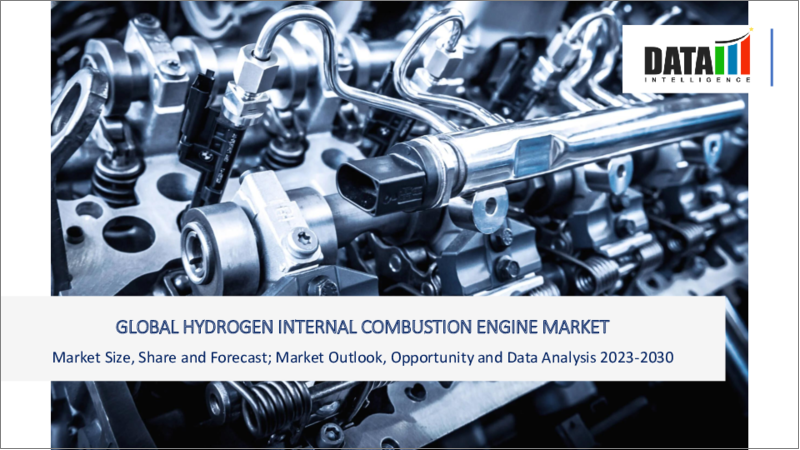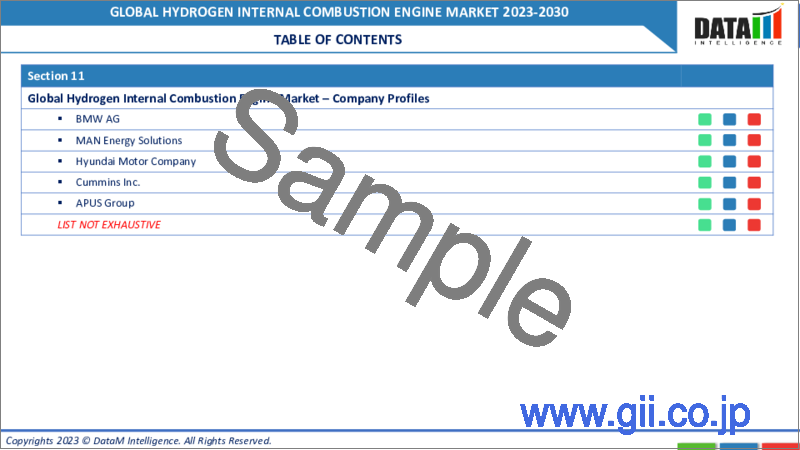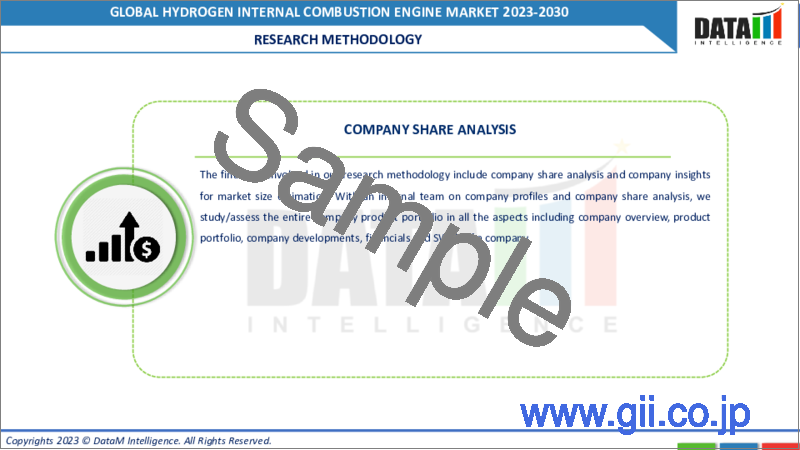|
|
市場調査レポート
商品コード
1382507
水素内燃エンジンの世界市場:2023年~2030年Global Hydrogen Internal Combustion Engine Market - 2023-2030 |
||||||
カスタマイズ可能
適宜更新あり
|
|||||||
| 水素内燃エンジンの世界市場:2023年~2030年 |
|
出版日: 2023年11月17日
発行: DataM Intelligence
ページ情報: 英文 215 Pages
納期: 即日から翌営業日
|
- 全表示
- 概要
- 目次
概要
水素内燃エンジンの世界市場は、2022年に276億米ドルに達し、2023年~2030年の予測期間中にCAGR10.1%で成長し、2030年には596億米ドルに達すると予測されています。
より大きな水素経済の中で、世界の水素内燃エンジン市場はダイナミックに成長している分野です。水素内燃エンジンは、環境に優しい選択肢を求めるセクターにとって、標準的な内燃エンジンの代替となり得るものです。
世界の主要企業は、インドでの自動車販売台数の増加を受けて、インドへの投資を検討しています。例えば、2023年9月に英国で水素エンジンが商業化されたのに続き、JCBはインドで水素エンジンを製造する予定です。現在、JCBは世界事業向けにディーゼルエンジンを製造しているため、バラブガル工場は水素プログラムに参加するのに適した場所だと考えています。そのため、予測期間中、アジア太平洋地域ではインドが最も高い成長率CAGRを示すと思われます。
ダイナミクス
商用車フリート
多くの政府や地域が、商用車からの排出ガスを削減するための厳しい目標を設定しています。商用車フリートにおけるトラックやバスは、多くの場合、走行距離が長く、大量の温室効果ガスや汚染物質を排出する大型車です。水素ICEは、一般的なディーゼルエンジンやガソリンエンジンに代わるクリーンなエンジンであるため、排出ガス規制をクリアしたいフリートにとって魅力的な選択肢となります。
例えば、リライアンスインダストリーズは2023年2月、大型車向けにインド初の水素内燃エンジン技術ソリューションを発表しました。ネットカーボンゼロのビジョンの下、RILとその車両パートナーであるアショクレイランド社、その他数社のパートナーが共同でこの技術を開発しました。この技術を搭載した最初のエンジンは2022年初めにテストされました。
低排出ガスにより自動車セクターの需要拡大
自動車産業における電動化の導入は、かつてない高みに達しています。BEVへの移行は、鉱業、農業、その他のオフロード用途のような、大きな振動と発熱にさらされながら24時間高い出力を必要とする産業では成功していません。ディーゼルエンジンは、脱炭素化のために直ちにHCEに置き換わることが期待されています。
例えば、2023年2月、英国の建設機械会社であるJCBは、未来の燃料として水素に賭けており、機械の動力源となる水素エンジンをインドに導入することを目指しています。バックホーローダーで約55%の市場シェアを持つ同社は、水素ベースの内燃エンジンを開発しました。英国ではまだ実用化されていませんが、すでにバックホーローダーなど複数のオフロード機械でテストを行っています。標準的なディーゼルエンジンと同じ原理で作動する水素燃焼エンジンの利点は、炭素を排出せず、水蒸気のみを排出することです。
競合技術
フォトグラメトリーやスマートフォンベースの3Dスキャンアプリなどの競合技術を利用することで、消費者は費用を節約できるかもしれません。潜在的な消費者によっては大きな障壁となる可能性のある、特殊な3Dスキャニングハードウェアを購入する必要はありません。競合技術の中には、比較的簡単に使えるものもあります。スマートフォンのアプリを使えば、消費者はすでに持っている機器を使って3Dスキャンを取り込むことができるため、学習曲線が短くなり、3Dスキャンがより身近なものになります。
競合するテクノロジーは、特定の用途において、互いに勝ることが多いです。例えば、構造化光スキャナーはその精度の高さで知られており、品質管理やリバースエンジニアリングなど、精度を必要とする用途に推奨されています。このように特殊化されているため、ユーザーはそれぞれの要求をよりよく満たす異なる技術を選択することができます。
新しい施設の設立
燃料補給ステーション、水素製造工場、水素ICE製造工場などの新しい施設の開発は、水素インフラを強化します。これにより、輸送や産業利用など、さまざまな用途での水素の利用しやすさと利便性が向上します。
例えば、2023年10月には、水素製造プラント、燃料補給ステーション、水素ICE製造プラントなどの新しい施設の開発により、水素インフラが強化されます。これにより、輸送や産業用を含むさまざまな用途での水素の利用しやすさと利便性が向上します。
タタモーターズはプネーに2つの研究開発センターを開設し、水素内燃エンジンの開発と水素燃料の貯蔵・流通のためのインフラ整備に注力しています。この2つの施設は、水素内燃エンジン開発のためのエンジン試験のプラットフォームとして、また、燃料電池車とH2ICE車の両方に対応する水素燃料の貯蔵と輸送のための重要なインフラとして機能します。
目次
第1章 調査手法と調査範囲
第2章 定義と概要
第3章 エグゼクティブサマリー
第4章 市場力学
- 影響要因
- 促進要因
- 商用車フリート
- 低排出ガスにより自動車セクターからの需要拡大
- 新しい施設の設立
- 抑制要因
- 競合技術
- 機会
- 影響分析
- 促進要因
第5章 産業分析
- ポーターのファイブフォース分析
- サプライチェーン分析
- 価格分析
- 規制分析
- ロシア・ウクライナ戦争の影響分析
- DMI意見
第6章 COVID-19分析
第7章 車種別
- 乗用車
- 商用車
第8章 水素源別
- グリーン水素
- グレー水素
- ブルー水素
- その他の水素源
第9章 技術別
- 内燃エンジン
- デュアル燃料エンジン
第10章 用途別
- 輸送
- 発電
第11章 エンドユーザー別
- 輸送
- 産業用
- その他
第12章 地域別
- 北米
- 米国
- カナダ
- メキシコ
- 欧州
- ドイツ
- 英国
- フランス
- イタリア
- ロシア
- その他欧州
- 南米
- ブラジル
- アルゼンチン
- その他南米
- アジア太平洋地域
- 中国
- インド
- 日本
- オーストラリア
- その他アジア太平洋地域
- 中東・アフリカ
第13章 競合情勢
- 競合シナリオ
- 市況/シェア分析
- M&A分析
第14章 企業プロファイル
- Toyota Industries Corporation
- 企業概要
- 水素供給源のポートフォリオと概要
- 財務概要
- 主な発展
- BMW Group
- Hyundai Motor Company
- Mazda Motor Corporation
- JCB
- ABB
- Opel/Vauxhall(Stellantis Group)
- Ballard Power Systems
- Jaguar Land Rover Automotive Plc
- Hyster-Yale Group
第15章 付録
Overview
Global Hydrogen Internal Combustion Engine Market reached US$ 27.6 billion in 2022 and is expected to reach US$ 59.6 billion by 2030, growing with a CAGR of 10.1% during the forecast period 2023-2030.
Within the larger hydrogen economy, the global hydrogen internal combustion engine (ICE) market is a dynamic and growing sector. Hydrogen ICEs are a possible alternative to standard internal combustion engines for sectors looking for ecologically friendly options.
Key global players are looking to invest in India owing to the higher sales of the automotive in India. For instance, in September 2023, Following the commercialization of hydrogen-powered engines in UK, JCB intends to manufacture these engines in India. Because it currently builds diesel engines for JCB's global operations, the company sees its Ballabhgarh factory as a suitable location for participating in the hydrogen program. Therefore, India will be witnessing the highest growth rate CAGR in the Asia-Pacific during the forecasted period.
Dynamics
Commercial Vehicles Fleet
Many governments and regions have set rigorous targets for reducing emissions from commercial vehicles. Trucks and buses in commercial fleets are often high-mileage, heavy-duty vehicles that release significant amounts of greenhouse gases and pollutants. Hydrogen ICEs are a cleaner alternative to typical diesel or gasoline engines, making them an appealing option for fleets looking to fulfill emissions regulations.
For instance, in February 2023, Reliance Industries has introduced India's first Hydrogen Internal Combustion Engine technology solution for heavy-duty vehicles. Under the Net Carbon Zero vision, RIL and its vehicle partner Ashok Leyland, along with a few other partners, developed the technology jointly. The first engines powered by this technology were tested in early 2022.
Growing Demand from Automotive Sector Owing to Low Emission
Electrification adoption in the vehicle industry has reached previously unheard-of heights. Transitioning to BEVs has not been successful in industries such as mining, agriculture and other offroad applications, which require higher power outputs 24 hours a day while being subjected to significant vibrations and heat generation. Diesel-powered engines are expected to be replaced with HCEs immediately in order to decarbonize the engines.
For instance, in February 2023, JCB, a British construction equipment company, is banking on hydrogen as the fuel of the future and aims to bring it to India with its hydrogen-powered engines that will power the machines. The company, which has around a 55% market share in backhoe loaders, developed a hydrogen-based internal combustion engine. While it has yet to be commercially deployed in UK, it is already testing them on several of its off-road machines, such as backhoe loaders. The advantage of a hydrogen combustion engine, which works on the same principle as a standard diesel engine, is that it emits no carbon and only water vapor.
Competing Technologies
Consumers may conserve money by using competitive technologies such as photogrammetry and smartphone-based 3D scanning apps. It does not necessitate the purchase of specialized 3D scanning hardware, which might be a substantial barrier for some potential consumers. Some competing technologies are relatively easy to use. Smartphone apps, enable consumers to capture 3D scans using devices they already own, lowering the learning curve and making 3D scanning more approachable.
Competing technologies frequently outperform one another in specific applications. Structured light scanners, for example, are known for their great accuracy and are recommended for applications requiring precision, such as quality control and reverse engineering. Because of this specialization, users may choose different technologies that better meet their individual demands.
Establishment of New Facilities
The development of new facilities, such as refueling stations, hydrogen production plants and hydrogen ICE manufacturing plants, enhances the hydrogen infrastructure. It increases the accessibility and convenience of hydrogen for a variety of uses, including transportation and industrial use.
For instance, in October 2023, The development of new facilities, such as hydrogen production plants, refueling stations and hydrogen ICE manufacturing plants, enhances the hydrogen infrastructure. It increases the accessibility and convenience of hydrogen for a variety of uses, including transportation and industrial use.
Tata Motors has opened two R&D centers in Pune to focus on the development of a Hydrogen Internal Combustion Engine as well as the infrastructure for storing and distributing Hydrogen fuel. The two facilities will serve as a platform for engine testing for the development of a Hydrogen Internal Combustion Engine, as well as the critical infrastructure for storing and transporting Hydrogen fuel, catering to both Fuel Cell and H2ICE cars.
Segment Analysis
The global hydrogen internal combustion engine market is segmented based on vehicle, hydrogen source, technology, application, end-user and region.
In Order to Lower the Emission, Commercial Vehicle Segment Generates the Higher Demand for Hydrogen Powered Engines
For instance, in January 2023, The Indian Union Cabinet approved the National Green Hydrogen Mission to promote the hydrogen environment. Following this approval, the mission was included in Union Budget for Fiscal Year (FY) 24 with a budget allocation of INR 19,744 crore. The goal aims to produce 5 MMT (million metric tonnes) of green hydrogen annually by 2030 in order to decarbonize the industrial, mobility and energy sectors and reduce reliance on imported fossil fuels and feedstock.
The transportation industry accounts for 24% of direct CO2 emissions from fuel burning, accounting for 10% of global greenhouse gas emissions. Vehicles with zero-emission technologies contribute to the green industrial, environmental and economic shift. Therefore, the commercial vehicle manufacturers are shifting to hydrogen powered engines in order to lower the emission of harmful gases. Hence, commercial vehicle segment dominates the global segment share with more than 50% of the segmental share globally.
Geographical Penetration
Collaborative Projects Generates the Revenue for HICE Key Players in North American Market
North America was participating in joint initiatives to enhance hydrogen technology with foreign partners. The collaborations sought to hasten the development and implementation of hydrogen ICEs in the region.
Electric vehicles are leading the charge toward a cleaner, zero-emissions future, but some may be startled to learn that they are not alone. Biodiesel, hydrogen and even solar technology are other options. Therefore, the North America captures the more than 1/3rd of the global hydrogen internal combustion engine market.
For instance, in November 2022, Tata Motors, India's largest commercial vehicle manufacturer and Cummins Inc., a global power solutions provider best known for its diesel engines, recently signed a Memorandum of Understanding to collaborate on the design and development of low and zero-emission commercial vehicles in India. It could include hydrogen-fueled internal combustion vehicles, fuel cells and electric vehicles driven by batteries.
COVID-19 Impact Analysis
The pandemic's economic uncertainties slowed investments and financing for hydrogen initiatives, especially hydrogen ICE development. Many enterprises in the hydrogen industry suffered financial difficulties. The automotive industry, a major user of hydrogen ICE technology, saw a drop in production and sales as a result of lockdowns and lower consumer demand. It has a direct impact on the car industry's adoption of hydrogen ICEs.
Russia-Ukraine War Impact Analysis
The protracted war has caused political and economic uncertainty in the region, resulting in a decrease in consumer spending power. Furthermore, the epidemic has significantly disrupted supply networks, causing firms to face manufacturing and distribution issues. As a result of the combined influence of these factors, the market is predicted to rise slowly.
However, it is crucial to remember that Hydrogen Internal Combustion Engine (ICE) are regarded critical components and when the situation stabilizes, demand for these items is projected to rebound. Major manufacturers with wide client bases, the flexibility to adjust to output variations and strong financial capacities are likely to benefit the most in this scenario, as they can navigate through protracted periods of uncertainty.
By Vehicle
- Passenger Cars
- Commercial Vehicles
By Hydrogen Source
- Green Hydrogen
- Grey Hydrogen
- Blue Hydrogen
- Other Sources
By Technology
- Internal Combustion Engine (ICE)
- Dual-Fuel Engines
By Application
- Transportation
- Power Generation
By End-User
- Transportation
- Industrial
- Others
By Region
- North America
- U.S.
- Canada
- Mexico
- Europe
- Germany
- UK
- France
- Italy
- Russia
- Rest of Europe
- South America
- Brazil
- Argentina
- Rest of South America
- Asia-Pacific
- China
- India
- Japan
- Australia
- Rest of Asia-Pacific
- Middle East and Africa
Key Developments
- In October 2023, AVL, an Austrian mobility technology company, confirmed operations that showed its prototype 2.0-liter turbo hydrogen race engine producing more than 200 horsepower per liter. AVL employs a water-injection system in conjunction with their turbocharger to moderate combustion for a cleaner burn and increased power output and it appears to be working well.
- In October 2023, The 2023 Japan Mobility Show, which will begin with the first press day on October 25, will be more than just about vehicles, as firms will also present different forms of mobility solutions. Yamaha Unveils Hydrogen-Burning Combustion Engine Buggy.
- In February 2023, JCB, a British construction equipment company, is banking on hydrogen as the fuel of the future and aims to bring it to India with its hydrogen-powered engines that will power the machines.
Competitive Landscape
major global players in the market include: Toyota Industries Corporation, BMW Group, Hyundai Motor Company, Mazda Motor Corporation, JCB, ABB, Opel/Vauxhall (Stellantis Group), Ballard Power Systems, Jaguar Land Rover Automotive plc and Hyster-Yale Group.
Why Purchase the Report?
- To visualize the global hydrogen internal combustion engine market segmentation based on vehicle, hydrogen source, technology, application, end-user and region, as well as understand key commercial assets and players.
- Identify commercial opportunities by analyzing trends and co-development.
- Excel data sheet with numerous data points of hydrogen internal combustion engine market-level with all segments.
- PDF report consists of a comprehensive analysis after exhaustive qualitative interviews and an in-depth study.
- Hydrogen Source mapping available as excel consisting of key products of all the major players.
The global hydrogen internal combustion engine market report would provide approximately 77 tables, 74 figures and 215 Pages.
Target Audience 2023
- Manufacturers/ Buyers
- Industry Investors/Investment Bankers
- Research Professionals
- Emerging Companies
Table of Contents
1. Methodology and Scope
- 1.1. Research Methodology
- 1.2. Research Objective and Scope of the Report
2. Definition and Overview
3. Executive Summary
- 3.1. Snippet by Vehicle
- 3.2. Snippet by Hydrogen Source
- 3.3. Snippet by Technology
- 3.4. Snippet by Application
- 3.5. Snippet by Region
4. Dynamics
- 4.1. Impacting Factors
- 4.1.1. Drivers
- 4.1.1.1. Commercial Vehicles Fleet
- 4.1.1.2. Growing Demand from Automotive Sector Owing to Low Emission
- 4.1.1.3. Establishment of New Facilities
- 4.1.2. Restraints
- 4.1.2.1. Competing Technologies
- 4.1.3. Opportunity
- 4.1.4. Impact Analysis
- 4.1.1. Drivers
5. Industry Analysis
- 5.1. Porter's Five Force Analysis
- 5.2. Supply Chain Analysis
- 5.3. Pricing Analysis
- 5.4. Regulatory Analysis
- 5.5. Russia-Ukraine War Impact Analysis
- 5.6. DMI Opinion
6. COVID-19 Analysis
- 6.1. Analysis of COVID-19
- 6.1.1. Scenario Before COVID
- 6.1.2. Scenario During COVID
- 6.1.3. Scenario Post COVID
- 6.2. Pricing Dynamics Amid COVID-19
- 6.3. Demand-Supply Spectrum
- 6.4. Government Initiatives Related to the Market During Pandemic
- 6.5. Manufacturers Strategic Initiatives
- 6.6. Conclusion
7. By Vehicle
- 7.1. Introduction
- 7.1.1. Market Size Analysis and Y-o-Y Growth Analysis (%), By Vehicle
- 7.1.2. Market Attractiveness Index, By Vehicle
- 7.2. Passenger Cars*
- 7.2.1. Introduction
- 7.2.2. Market Size Analysis and Y-o-Y Growth Analysis (%)
- 7.3. Commercial Vehicles
8. By Hydrogen Source
- 8.1. Introduction
- 8.1.1. Market Size Analysis and Y-o-Y Growth Analysis (%), By Hydrogen Source
- 8.1.2. Market Attractiveness Index, By Hydrogen Source
- 8.2. Green Hydrogen*
- 8.2.1. Introduction
- 8.2.2. Market Size Analysis and Y-o-Y Growth Analysis (%)
- 8.3. Grey Hydrogen
- 8.4. Blue Hydrogen
- 8.5. Other Sources
9. By Technology
- 9.1. Introduction
- 9.1.1. Market Size Analysis and Y-o-Y Growth Analysis (%), By Technology
- 9.1.2. Market Attractiveness Index, By Technology
- 9.2. Internal Combustion Engine (ICE)*
- 9.2.1. Introduction
- 9.2.2. Market Size Analysis and Y-o-Y Growth Analysis (%)
- 9.3. Dual-Fuel Engines
10. By Application
- 10.1. Introduction
- 10.1.1. Market Size Analysis and Y-o-Y Growth Analysis (%), By Application
- 10.1.2. Market Attractiveness Index, By Application
- 10.2. Transportation*
- 10.2.1. Introduction
- 10.2.2. Market Size Analysis and Y-o-Y Growth Analysis (%)
- 10.3. Power Generation
11. By End-User
- 11.1. Introduction
- 11.1.1. Market Size Analysis and Y-o-Y Growth Analysis (%), By End-User
- 11.1.2. Market Attractiveness Index, By End-User
- 11.2. Transportation*
- 11.2.1. Introduction
- 11.2.2. Market Size Analysis and Y-o-Y Growth Analysis (%)
- 11.3. Industrial
- 11.4. Others
12. By Region
- 12.1. Introduction
- 12.1.1. Market Size Analysis and Y-o-Y Growth Analysis (%), By Region
- 12.1.2. Market Attractiveness Index, By Region
- 12.2. North America
- 12.2.1. Introduction
- 12.2.2. Key Region-Specific Dynamics
- 12.2.3. Market Size Analysis and Y-o-Y Growth Analysis (%), By Vehicle
- 12.2.4. Market Size Analysis and Y-o-Y Growth Analysis (%), By Hydrogen Source
- 12.2.5. Market Size Analysis and Y-o-Y Growth Analysis (%), By Technology
- 12.2.6. Market Size Analysis and Y-o-Y Growth Analysis (%), By Application
- 12.2.7. Market Size Analysis and Y-o-Y Growth Analysis (%), By End-User
- 12.2.8. Market Size Analysis and Y-o-Y Growth Analysis (%), By Country
- 12.2.8.1. U.S.
- 12.2.8.2. Canada
- 12.2.8.3. Mexico
- 12.3. Europe
- 12.3.1. Introduction
- 12.3.2. Key Region-Specific Dynamics
- 12.3.3. Market Size Analysis and Y-o-Y Growth Analysis (%), By Vehicle
- 12.3.4. Market Size Analysis and Y-o-Y Growth Analysis (%), By Hydrogen Source
- 12.3.5. Market Size Analysis and Y-o-Y Growth Analysis (%), By Technology
- 12.3.6. Market Size Analysis and Y-o-Y Growth Analysis (%), By Application
- 12.3.7. Market Size Analysis and Y-o-Y Growth Analysis (%), By End-User
- 12.3.8. Market Size Analysis and Y-o-Y Growth Analysis (%), By Country
- 12.3.8.1. Germany
- 12.3.8.2. UK
- 12.3.8.3. France
- 12.3.8.4. Italy
- 12.3.8.5. Russia
- 12.3.8.6. Rest of Europe
- 12.4. South America
- 12.4.1. Introduction
- 12.4.2. Key Region-Specific Dynamics
- 12.4.3. Market Size Analysis and Y-o-Y Growth Analysis (%), By Vehicle
- 12.4.4. Market Size Analysis and Y-o-Y Growth Analysis (%), By Hydrogen Source
- 12.4.5. Market Size Analysis and Y-o-Y Growth Analysis (%), By Technology
- 12.4.6. Market Size Analysis and Y-o-Y Growth Analysis (%), By Application
- 12.4.7. Market Size Analysis and Y-o-Y Growth Analysis (%), By End-User
- 12.4.8. Market Size Analysis and Y-o-Y Growth Analysis (%), By Country
- 12.4.8.1. Brazil
- 12.4.8.2. Argentina
- 12.4.8.3. Rest of South America
- 12.5. Asia-Pacific
- 12.5.1. Introduction
- 12.5.2. Key Region-Specific Dynamics
- 12.5.3. Market Size Analysis and Y-o-Y Growth Analysis (%), By Vehicle
- 12.5.4. Market Size Analysis and Y-o-Y Growth Analysis (%), By Hydrogen Source
- 12.5.5. Market Size Analysis and Y-o-Y Growth Analysis (%), By Technology
- 12.5.6. Market Size Analysis and Y-o-Y Growth Analysis (%), By Application
- 12.5.7. Market Size Analysis and Y-o-Y Growth Analysis (%), By End-User
- 12.5.8. Market Size Analysis and Y-o-Y Growth Analysis (%), By Country
- 12.5.8.1. China
- 12.5.8.2. India
- 12.5.8.3. Japan
- 12.5.8.4. Australia
- 12.5.8.5. Rest of Asia-Pacific
- 12.6. Middle East and Africa
- 12.6.1. Introduction
- 12.6.2. Key Region-Specific Dynamics
- 12.6.3. Market Size Analysis and Y-o-Y Growth Analysis (%), By Vehicle
- 12.6.4. Market Size Analysis and Y-o-Y Growth Analysis (%), By Hydrogen Source
- 12.6.5. Market Size Analysis and Y-o-Y Growth Analysis (%), By Technology
- 12.6.6. Market Size Analysis and Y-o-Y Growth Analysis (%), By Application
- 12.6.7. Market Size Analysis and Y-o-Y Growth Analysis (%), By End-User
13. Competitive Landscape
- 13.1. Competitive Scenario
- 13.2. Market Positioning/Share Analysis
- 13.3. Mergers and Acquisitions Analysis
14. Company Profiles
- 14.1. Toyota Industries Corporation*
- 14.1.1. Company Overview
- 14.1.2. Hydrogen Source Portfolio and Description
- 14.1.3. Financial Overview
- 14.1.4. Key Developments
- 14.2. BMW Group
- 14.3. Hyundai Motor Company
- 14.4. Mazda Motor Corporation
- 14.5. JCB
- 14.6. ABB
- 14.7. Opel/Vauxhall (Stellantis Group)
- 14.8. Ballard Power Systems
- 14.9. Jaguar Land Rover Automotive Plc
- 14.10. Hyster-Yale Group
LIST NOT EXHAUSTIVE
15. Appendix
- 15.1. About Us and Services
- 15.2. Contact Us






